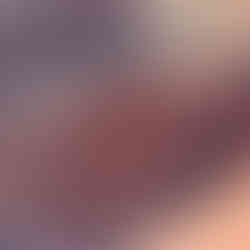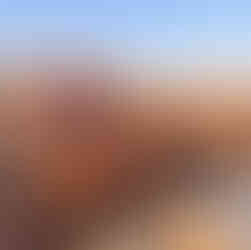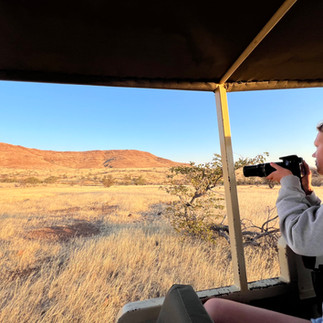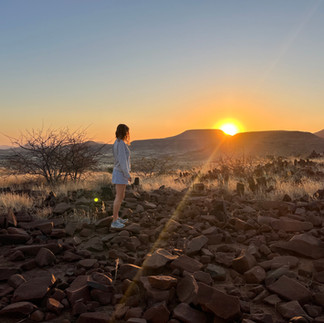Namibia part 6: endless skies, inner peace
- guymavor
- Aug 23
- 6 min read

An hour north of EHRA, we stop at some (well, a vast numbers of) rock engravings at Twyfelfontein. When I came here in 1994, there were no facilities and nothing but your conscience preventing you from clambering all over the rocks. Now there is a visitors’ centre and a clear path around the site, to limit the damage clambering has clearly done. There are also excellent local guides who will tell you about the engravings. They differ from the paintings at the Brandberg in that there are far more in a concentrated area, they are carved not painted, and some of them are a what a certain kind of art snob might call ‘amateurish’. They are no less interesting for it.
They are the output of a wider range of artists, and there is a much greater variety of animals, including some unusual desert creatures: penguins, seals, indicating that this was a gathering point for people who ranged far and wide – the nearest penguins are currently at Lüderitz, but they could have been closer 2000 years ago. There are also creatures with human features, which suggests similar motivation for carving as in the Brandberg art, which I prefer. Sian prefers this place. UNESCO agree with her: it was granted World Heritage status in 2007 as "a coherent, extensive and high quality record of ritual practices relating to hunter-gather communities over at least two millennia". Both places are special (the Organ Pipes nearby less so, if you have been to Fingal’s Cave on Staffa in Scotland, or the Giant’s Causeway in N Ireland).

We drive on along a cascading road, new vistas at every turn. There is a brief section of tar road, perhaps to cope with steeper gradients. The landscape changes from red granite koppies to low ranges of sometimes paler, sometimes blacker rock. We are in sparser conservancy territory now, with few if any smallholdings. Since the turn of the Millenium, this landscape has turned decisively away from ranching, and towards conservation tourism. Perhaps it is a recognition that fickle rainfall is never going to underpin a solid farming economy, but there is also the feeling that tourism pays, especially high-end, although there are many spectacular community campsites up here too, and potentially high-adrenaline experiences, in the case of black rhino tracking on foot, offered by some lodges in conjunction with Save the Rhinos rangers, which we are not attempting. Either way, fences have disappeared over the last two decades, and wild animals have a vast range up here.
After our first experience of the veterinary fence which crosses northern Namibia, we leave the car at the Palmwag Lodge campsite and are met by Once, who has come to take us to Etendeka, in the rolling foothills of the Grootberg mountains, where we will spend a couple of days hiking and feeling like the only people on earth. The drive up into this hidden kingdom is beautiful in the late sunshine, with grasses and explosions of reddening basalt catching the warm light. We see oryx, our first giraffe in a river valley, and our first mountain zebra, having missed them in the Naukluft (Hartmann’s, more slender than the Burchell’s plains zebra, and with a dewlap and stripes which go all the way down their legs but not round their bellies). Again, it is a landscape transformed by this year’s rains. In every picture I have seen of Etendeka in recent years there is barely any grass. Red rock predominates. Now, though, dry vegetation shimmers away. The grazing looks abundant, green in the kloofs where there are still pools of water. The lack of abundant grazers, however, gives a better clue to the nature of this environment: it is usually harsh. Most animals need to move large distances for sustenance, roaming way beyond the 400sq km of this concession. But there is life here, and evidence of predators and megafauna passing through. On the way up to the lodge we stop and see hyena tracks and those of a lone elephant bull, but they are a few days old, Once says. The next day we will see recent rhino tracks on a path and spot the rangers who follow these precious animals. These men and women are often based at Etendeka, but it doesn’t mean that the rhinos are easy to find. They travel long distances every day, up and down steep gradients. We don’t get any closer than these tracks, which is fine. It is enough to know that they are around, still roaming free outside national parks. And we will see them in Etosha, as it turns out. Many of them.
Etendeka is a genuine solar-powered eco-camp, and has a magic about it, from being owner-run, from its clear sense of low-footprint purpose, and from it setting. It exists both to showcase and restore the area’s natural beauty and to benefit communities on the northern edge of the reserve with employment, upskilling and development, a shining example of the conservancy model. Dennis, the owner, has been here since 1991. Manager Kapoi’s warm welcome and easy manner are those of an experienced host – he has worked everywhere, in some really classy (read: expensive) lodges in South Africa and Zambia – but it is much more than that. As a son of Opuwo, the closest reasonable-sized town (250km away…), this vast, stark, mountain landscape has a special place in his heart. It really is home for Dennis too, who originally set the camp up under the Wilderness umbrella, but has run it independently for decades. He has some great stories and continues to wonder at this continent’s huge wildernesses (“I’ve never seen such fat oryx,” he says of his recent 1000km camping trip in the Central Kalahari Game Reserve, which also received huge rains this year. It exhausted his Land Rover but not his enthusiasm), and obvious pride in the lodge and affection for the people here.
Etendeka, Dennis is keen to emphasise, markets itself as a wilderness rather than a wildlife experience. There is plenty of the latter, and you can get very lucky with sightings. We enjoyed our giraffes feeding in a gully, our zebra and oryx herds at sunset and our rhino, elephant and hyena tracks, but that is not the point, which is exploration with a guide who knows the landscape intimately, on foot or in the open Land Rover, and absorption, of light, air, sounds, stories.


You can also sit outside your tent and watch the landscape, the stars, or even elephant shrews scuttling by. The tiny pond-like waterhole by the main building is the lodge’s only alteration to the local ecology, the urge to drill boreholes in times of drought resisted. It is a good spot to watch the parade of shrikes and other birds arriving to drink, the doves holding back until I retreat indoors. Small mammals will come by too. We also find ourselves sharing our outdoor bathroom, complete with bucket shower - with a gecko.
There are 3-day hikes across the reserve, cooking out in the bush and sleeping in beds in expedition tents on raised platforms. It is the ultimate slackpacking experience. You can also walk out from the lodge on various routes, which is what we do, and do a sundowner drive and the game drives up and down the mountain. Dinners are at a long, communal table at which conversation flows and people enjoy themselves.
At walking pace, you notice things, although it helps that Boas is showing us too. An ant raid on a termite nest (big mounds are not possible in this rocky ground), oryx and giraffe skulls, crystal formations, snake skins, 'shepherd' trees and their significance to locals (it's more than just shade), the tracks around pools of water still going strong after the rains but also from hidden springs, birdlife including Egyptian geese, korhaans croaking away and rosy-faced lovebirds. Large groups of resident swifts also fly through. It was a peaceful walking daydream, although there is always the potential for an adrenaline surge in these parts, with large animals passing through. That would have been ‘exciting’, but I’m glad it didn’t happen. Etendeka was the zen we needed mid-trip, a yoga-and-wellness retreat without the need for either.


























































Comments